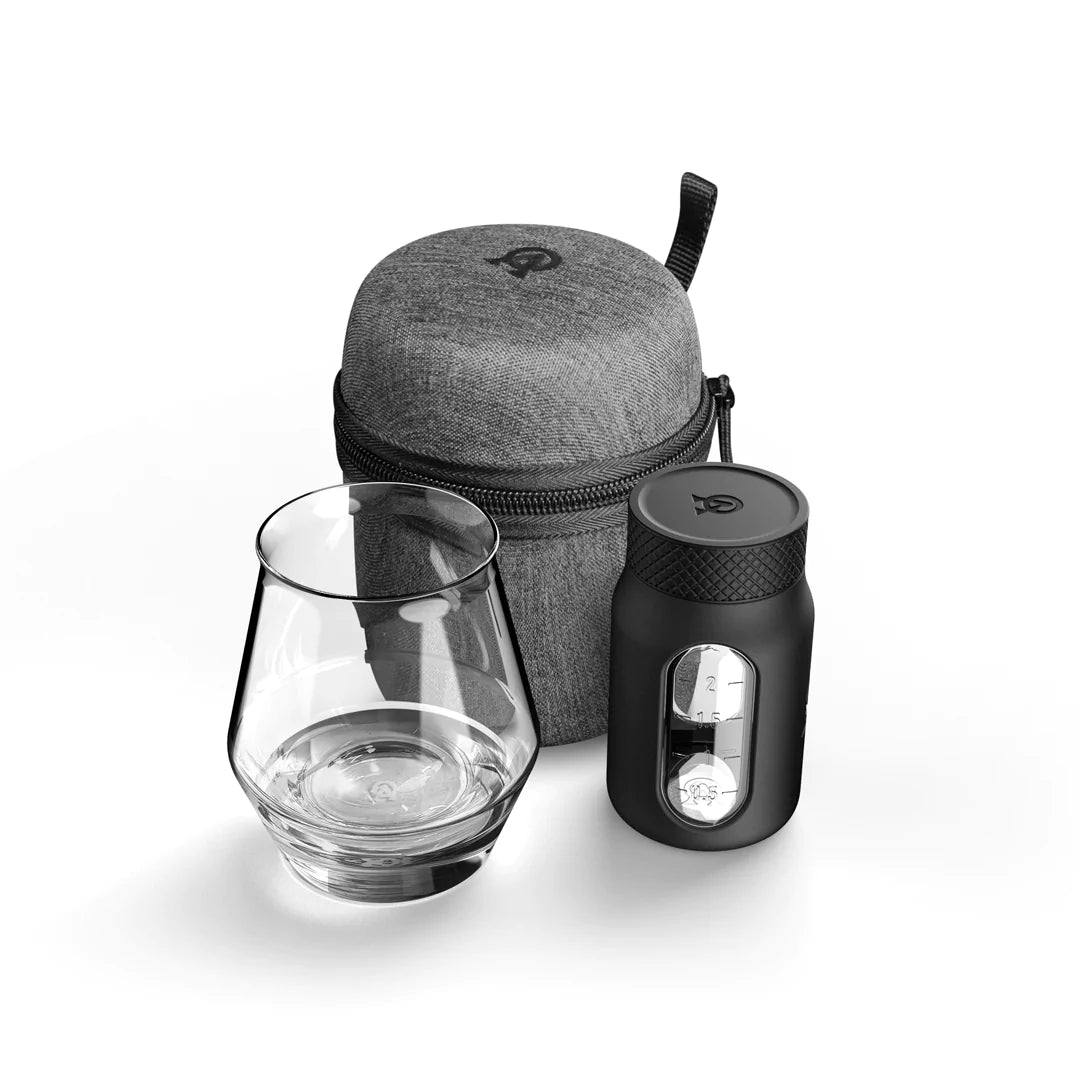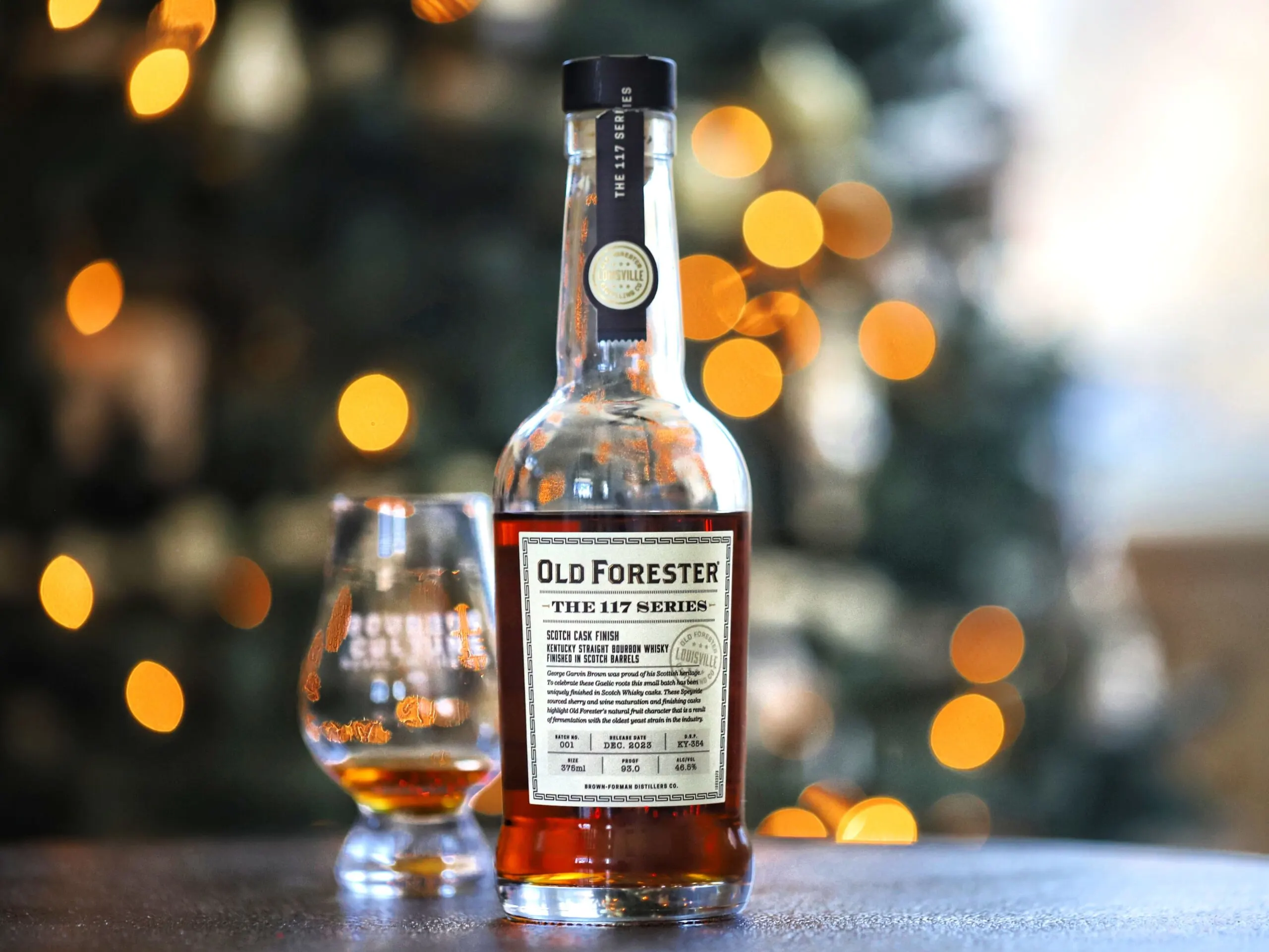| Don't like ads? | No ads |
If you haven’t noticed lately, a lot of the big corporations that own multiple spirits companies have been trying to create collaborations between their brands. Sometimes the collaboration is between industry icons – like what happened with Jim Beam’s Legent. Beam/Suntory’s corporate office paired Fred Noe and Shinji Fukuyo up to create a unique sherried bourbon. But for the most part, corporations enable collaborations through barrel-shares whereby one distillery sends another distillery their barrels to finish or age a product in. One of the most recent examples of this is when Campari facilitated the exchange of rum barrels from Appleton Estate to Wild Turkey. This is how we ended up with Wild Turkey Master’s Keep Voyage.
Now it’s Brown-Forman’s turn. You may not know this, but BF owns a handful of distilleries in other countries including three in Scotland: Benriach, GlenDronach and Glenglassaugh. A plan was hatched whereby Old Forester would finish their bourbon in casks that previously held Scotch Whisky. This is the opposite of what usually happens because used bourbon barrels are typically sent over to Scotch producers to age their whiskey in it. But every product needs a story behind it, so the marketing department wanted to draw attention to George Garvin Brown’s Scottish lineage as the reason for creating this.

Creating a bourbon finished in Scotch casks was only going to be the second time in the brand’s history that their bourbon would be finished in a secondary cask. The first example was Old Forester 1910. That product uses a second, newly-charred oak barrel for additional aging. One could argue that 1910 didn’t move the needle that far in terms of experimentation. The final product still looked, smelled and tasted like a bourbon. So this Scotch Cask Finish would still feel like it was exploring a new concept.
What goes into The 117 Series: Scotch Cask Finish?
There is a split among producers of finished whiskies in the US on how they go about introducing the liquid to a secondary barrel. Most producers finish their whiskey by filling up the secondary barrel with cask strength liquid. Then there are those who proof down the bourbon before it enters the finishing barrel. For example; High West dilutes their aged whiskey down to 100 proof first before it enters into a finishing barrel.
It turns out that Brown-Forman brands do that too. Woodford Reserve Double Oaked and the finished versions of Jack Daniel’s/Woodford Reserve Distillery Series all get proofed down to 100 before entering their secondary barrel. Even Old Forester adopted this practice for their release of 1910 Old Fine Whisky.

Why proof down a whiskey prior to putting it in a finishing cask? One reason revolves around how a whiskey with a higher water content (i.e. less alcohol) can more-readily dissolve certain wood sugars and bond with other flavors. Another reason is that a lower proof will help reduce the strong oaked bourbon note so that the finishing cask can be tasted. And since bourbon is more powerful than Scotch because of the impact of the new charred oak barrels, it needed to become as mellow as possible to allow the mild Scotch flavors to shine.
A peek into the Scotch Casks that Old Forester used
Most non-Scotch drinkers probably think that a majority of Scotch is peated (a taste most describe as “smokey”). That’s definitely not the case. I would say that less than a quarter of all Scotch is peated. And more to the point, the brands that Brown-Forman own almost exclusively make non-peated Scotch. But Scotch isn’t just categorized as peated or non-peated – there are a wide range of casks that producers mature or finish their Scotch in. These are used to enhance the flavors that the customer will experience. A majority of the time some sort of wine cask is used – with varieties of Sherry being the most popular.
The Scotch casks that Old Forester received were “mostly” from GlenDronach and Benriach. Once they were filled with matured bourbon, they were allowed to rest for 2 years before they were declared finished. These casks all held non-peated Scotch in them prior to being shipped to the US. And before they were aging Scotch in them, they were previously aging Sherry and Moscatel fortified wines as well as bourbon and rye whiskey from Jack Daniel’s, Woodford Reserve and Old Forester.

It is unknown how many casks in total were used or what their yield was, but previous “117 Series” releases have been in the neighborhood of 30-50 barrels. So how did this limited release turn out? Let’s find out. A special thanks to my friend James for the help in securing my own bottle. I sampled this neat in a glencairn.
Tasting Notes
Nose: The caramel from the bourbon seems to be competing with the honey’ed scent of the residual Scotch trapped deep within the staves of the finishing casks. Soft notes like fruit preserves (apricot, strawberry and blueberry) mingle with meringue and sweet cereal grains making this one of the more approachable Old Forester products I’ve had. The oak is present, but doesn’t smell like a traditional bourbon. I’m very surprised just how much the Scotch casks lightened up the heavy oak scents I’d typically find.
Palate: Sweet, jammy fruits coat my tongue while vanilla and soft oak flavors bring up the rear. The Sherry notes are accessible and showcase some wine and peppery spice the longer you sip on it. There is a honey sweetness that is surely from the malt whiskey barrels. Tannins can be tasted, but are on the lighter side and include pipe tobacco, fresh leather and seasoned oak. Ground cinnamon and nutmeg flavors provide a level of spice, but it’s nowhere near the level I’ve had in standard Old Forester products. There is so little heat that I could hold this in my mouth forever.
Finish: The finish still sees a lingering honey sweetness. Only at the end do I pick up some musty notes likely from the very old casks. I wonder how long the Scotch was aged in the barrels prior to them being used in this release? It had to be a long time. Vanilla lemon custard flavors combine with just a hint of spice too.
Score: 7.8/10
At times coming off like a Scotch and other times coming off as a bourbon, this seems to be the perfect marriage of two distinct whiskies. It is perfectly drinkable with the ability to have glass after glass without feeling like my tastebuds were wiped out. The heavy oak notes that are typical with Old Forester products feel like they’ve been pruned back enough to the point where I don’t get the palate fatigue that drinking bourbon usually causes (seriously, how does Fred Minnick drink 20+ whiskies in one setting and not wipe out his tongue?).

The easiest way to describe this bottle is a fruity, easygoing sipper. It’s going to reward the typical bourbon sipper with flavors that could be new to them, but won’t burn them out. This is unique in that regard and an experience that I think is lost on the larger enthusiast community who consider themselves “proof hounds.”
Final Thoughts
Old Forester Scotch Cask Finish delivered everything I thought it would. Just like Birthday Bourbon, this is a whiskey that requires thoughtful sipping to suss out all of the notes that it holds. If you need a big, brute barrel strength bourbon to make you pay attention, this bottle is going to let you down. But it really shouldn’t. Sometimes the delicate notes are just as intriguing to discover.
There’s not much to expand on considering the value aspect of this 117 Series release. I do think it will be one of the slower-selling ones and one that doesn’t have much of a secondary market upcharge to it. Probably because putting the word “Scotch” on any bourbon product is similar to drinking orange juice after brushing your teeth for most enthusiasts. But this is a superb example that two opposite flavors working in harmony rather than creating something worse.
Not every 117 Series is going to be a home-run for every enthusiast out there, but it’s refreshing to see Old Forester (and Brown-Forman) trying to keep things fresh and new. I just wish these were a little easier to find.
Featured Products
- Neat Traveler

- View Larger
- Description:The Aged & Ore Neat Traveler is a complete travel kit for spirits. We combined our widely praised Neat Glass with one of our 3oz Flight Bottles and housed them together in a custom EVA travel case. Perfect for a night away with your favorite pour. The tie
- Bottle Flight

- View Larger
- Description:The Aged & Ore Bottle Flight is a premium set of 4 custom silicone wrapped glass bottles designed to transport and share samples of your favorite spirits. The flight bottles come in a custom EVA travel case that fits perfectly in any small bag. An Aged &
- Travel Bundle

- View Larger
- Description:This Bundle combines two of our crowd favorite products, creating the ultimate travel bundle to bring along your favorite spirits and glassware. Bundle Includes: Neat Traveler (Gray) Bottle Flight (Gray) Note: This bundle is only available in gray and col
*Bourbon Culture is reader-supported. When you buy through links on our site, we may earn an affiliate commission.

